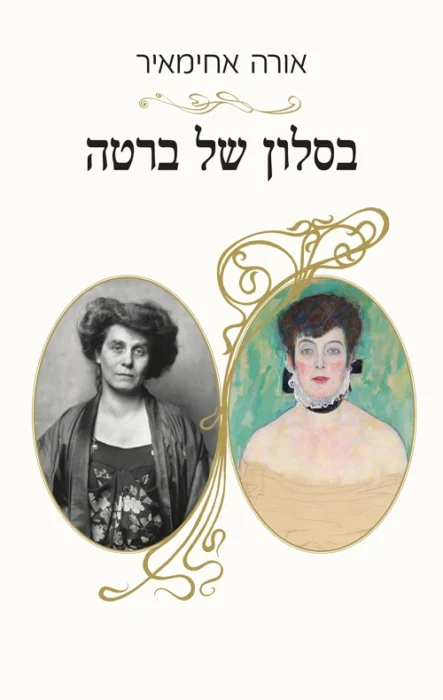Please scroll down for an English review.
הספר בסלון של ברטה מאת אורה אחימאיר הוא מסע אישי והיסטורי גם יחד: מצד אחד סיפור חייה של המחברת, שמגיעה בעשור השמיני לחייה כדי לחקור את הקשר המשפחתי האפשרי שלה לענף משפחת צוקרקנדל הווינאי, ומצד שני ביוגרפיה חיה ותוססת של ברטה צוקרקנדל, אחת הדמויות המשפיעות ביותר בתרבות וינה סביב 1900.
ברטה הקימה סלון תרבותי שהפך למרכז אינטלקטואלי ואמנותי. אל סלונה הגיעו אמנים כמו גוסטב קלימט, סופרים כארתור שניצלר, מלחינים ובראשם גוסטב מהלר, וגם פוליטיקאים ואנשי רוח. היא לא נשאה בתפקיד רשמי, אך הייתה הכוח המניע מאחורי התפתחויות תרבותיות רבות – באמנות, בספרות, במוזיקה ואף בניצני הפמיניזם הווינאי.
אחימאיר מתארת את עוצמתה של ברטה: כיצד שרדה כאלמנה צעירה, כיצד תרמה לקידום נשים בתקופה שבה הפטריארכיה שלטה בכל תחום, ואיך התגייסה במלוא כוחה לקידום רעיונות של שלום בזמן מלחמת העולם הראשונה. חלק מרכזי בספר עוסק גם במערכת יחסיה עם ז'ורז' קלמנסו, מי שיהפוך לימים לנשיא צרפת, ובקשרים הפוליטיים שניצלה כדי לגשר בין עולמות שונים.
בצד הססגוני הזה מוצגת גם דמותה של אמליה צוקרקנדל, גיסתה של ברטה, שמופיעה בציורו הלא־גמור של גוסטב קלימט. אמליה חיה חיים קשים ומלאי סבל: נישואיה התפרקו, היא שקעה בעוני, ובסופו של דבר נשלחה למותה בשואה. דמותה מייצגת את הצד השברירי והכואב של התקופה, בניגוד לאנרגיה הציבורית ולברק התרבותי של ברטה.
באמצעות שתי הדמויות הללו מובילה המחברת את הקורא במסע אל חיי התרבות והבוהמה של וינה ופריז במפנה המאה: תיאורים חיים של היהודים האמידים, ניסיונותיהם להשתלב בחברה, והמתח המתמיד בין זוהר תרבותי לשבריריות קיומית.
בסלון של ברטה אינו רק ביוגרפיה, שחושפת את דמותה המרתקת ואת הרשת התרבותית שטוותה, אלא גם מפתח להבנת וינה 1900: כיצד נבנתה רשת תרבותית וחברתית שלמה סביב שולחן אחד, ואיך אישה אחת בלי תואר רשמי הפכה למנהלת האמנותית של עיר שלמה. זהו אחד הספרים הטובים ביותר שקראתי השנה, והוא מומלץ בחום.
בסלון של ברטה/ אורה אחימאיר
הוצאת עם עובד, 2022, 289 עמ'
דירוג SIVI –
איכות אודיו –

רוצים ללמוד עוד על התקופה?
The book In Berta’s Salon by Ora Ahimeir is both a personal and historical journey. On the one hand, it tells the story of the author herself, who, in her eighties, sets out to explore her possible family connection to the Viennese branch of the Zuckerkandl family. On the other hand, it presents a vivid and engaging biography of Berta Zuckerkandl, one of the most influential figures in Viennese culture around 1900.
Berta established a cultural salon that became a hub of intellectual and artistic activity. Through her doors passed artists such as Gustav Klimt, writers like Arthur Schnitzler, composers led by Gustav Mahler, as well as politicians and intellectuals. She never held an official role, yet she was the driving force behind much of the city’s cultural development – in art, literature, music, and even the early stirrings of Viennese feminism.
Ahimeir describes Berta’s remarkable strength, highlighting how she survived as a young widow, advanced the cause of women in an era dominated by patriarchy, and devoted herself entirely to promoting ideas of peace during the First World War. A central part of the book also explores her relationship with Georges Clemenceau, who would later become President of France, and the political connections she leveraged to bridge opposing worlds.
Alongside this colorful portrait stands the story of Amalie Zuckerkandl, Berta’s sister-in-law, immortalized in Gustav Klimt’s unfinished painting. Amalie endured a life of hardship and suffering: her marriage collapsed, she sank into poverty, and ultimately she was deported to her death in the Holocaust. Her figure represents the fragile and tragic side of the era, in stark contrast to Berta’s public energy and cultural radiance.
Through these two women, the author leads the reader on a journey into the cultural and bohemian life of Vienna and Paris at the turn of the century, offering vivid depictions of wealthy Jewish families, their efforts to integrate into society, and the constant tension between dazzling cultural achievements and existential vulnerability.
In Berta’s Salon is not merely a biography that reveals the fascinating story of Berta and the cultural network she wove, but also a key to understanding Vienna 1900: how an entire cultural and social network was built around a single salon table, and how one woman without any official title became the artistic director of a whole city. This is truly one of the best books I have read this year, and I warmly recommend it.
לגלות עוד מהאתר Sivi's Books
Subscribe to get the latest posts sent to your email.

